Google’s featured snippets are descriptive search results for any query that appears on the top of the SERP. Optimizing for featured snippets can assist Google in recognizing when your website is the best response for a relevant question. These are powerful in increasing your website’s traffic and reputation.
Google’s featured snippets aim to help users by catering to their needs right in the search box. Thus, these are now a crucial part of SEO strategies.
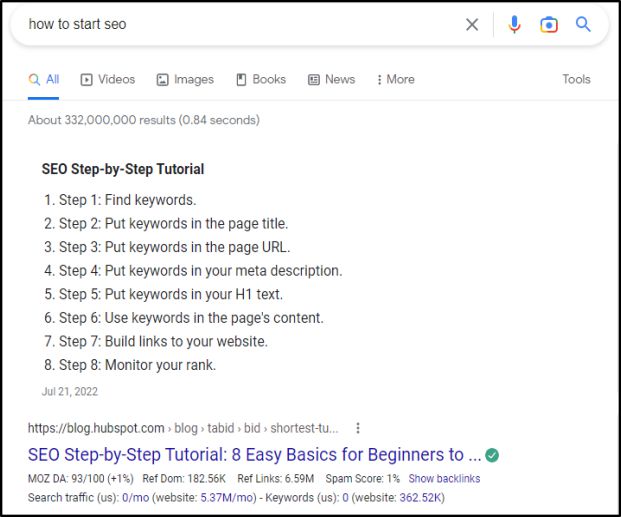
What is a featured snippet?
A featured snippet is taken from a web search listing. These are portions of websites’ informational content that are straightforward answers to the user’s search. Google’s automation algorithm determines whether a webpage content makes for a good snippet or not for a specific query.
One can see the owner of a featured snippet as the most relevant information for the query. A featured snippet can appear as text, list, table, image, or video.
Types of featured snippets
Google’s search algorithm automatically picks the most relevant content from the website and shows it as a featured snippet. These pieces of content display brief but straightforward answers to queries. If users intend to read the full information, then they can opt to open the URL of the featured snippet.

A featured snippet can be in any of the following forms.
- Paragraph (text)
- Bulleted list
- Numbered list
- Table
- Video
- Entity carousel
- Double featured snippets
- Two-for-one or combined snippet
- Paragraph (Text):
Paragraph snippets are the most basic type of highlighted google snippets. With this type, a paragraph delivers a crisp response to a question or suggests the information a web page includes. Often these snippets have highlighted words from the query or words with semantically similar words. In addition, Google may display subsections from the page to give an interesting summary.
You can make this snippet benefit your click-through rate (CTR) by addressing the query immediately and giving extra information that captivates the searcher’s curiosity.
You can dedicate a blog page for more complex queries, whereas FAQ pages are ideal for quickly responding to simple questions.
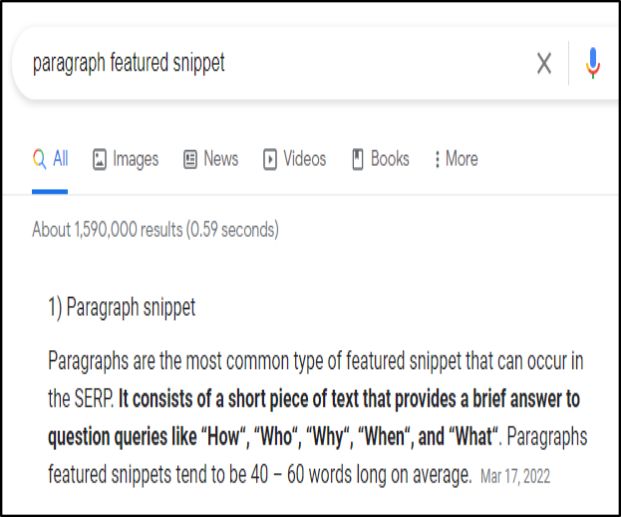
- Bulleted or unordered list:
A type of Google highlighted snippet that web users see frequently is a bulleted list. This snippet provides bullet points related to the corresponding Google search in an easy-to-understand manner. They’re excellent for displaying numerous variations on what a user is looking for.
From an SEO standpoint, keeping your unordered lists brief, straightforward, and focused on responding to specific questions can be highly beneficial.
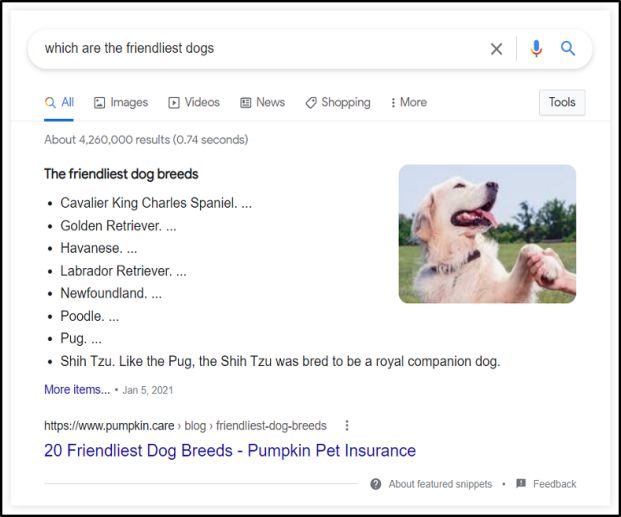
- Numbered or ordered list:
These snippets with text in numbered or sequential lists frequently outline steps of an action or process. These often display answers to “how to” or “how do I” questions. A numbered list may have a few items, or more than a dozen. To promote clicks, Google may shorten your list if it is too big while still showing a “more things” link.
Place your numbered list early on your page to improve SEO. This is because Google will better know where to start and which sections to choose for the snippet.
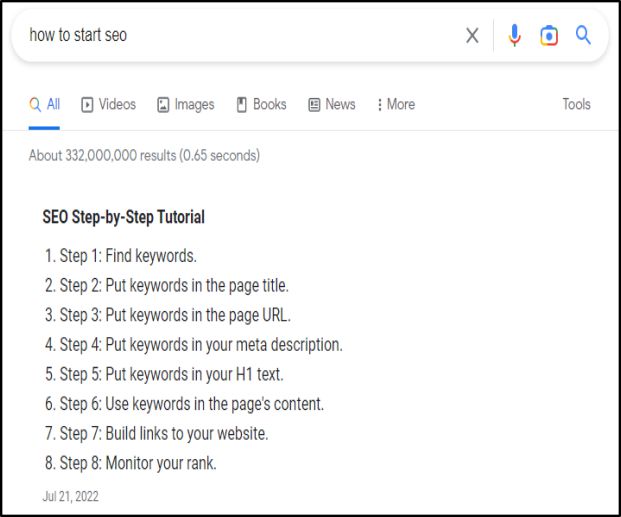
- Table:
A table is a commonly highlighted snippet that emphasizes a specific area of the table on the page. It typically shows up when people search for comparisons. Users can expand the rows in the excerpt to check how many are present. Google can extract the precise data the user is searching for and generate its table rather than merely pulling the data and spitting it out in the manner it’s formatted.
For tables, keep your content direct, concise, and clear so that Google can analyze and discover the pertinent portion for the search. It’s applicable even if you’re working with a ton of information.
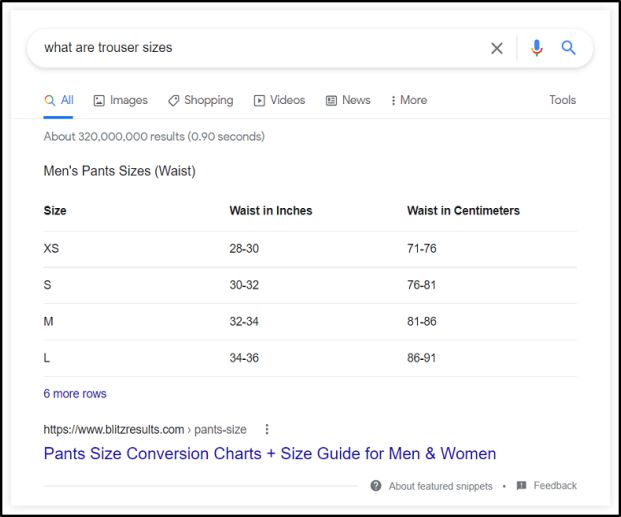
- Video:
These Google snippets are genuine videos that users may play to get the information they’re looking for. Additionally, many queries targeted at simpler-to-visualize processes return a video snippet. These clips will either be the complete version, or frequently, a suggested video segment.
Because of this, it’s crucial to use chapters and sections inside your videos so Google knows which bits to pull.
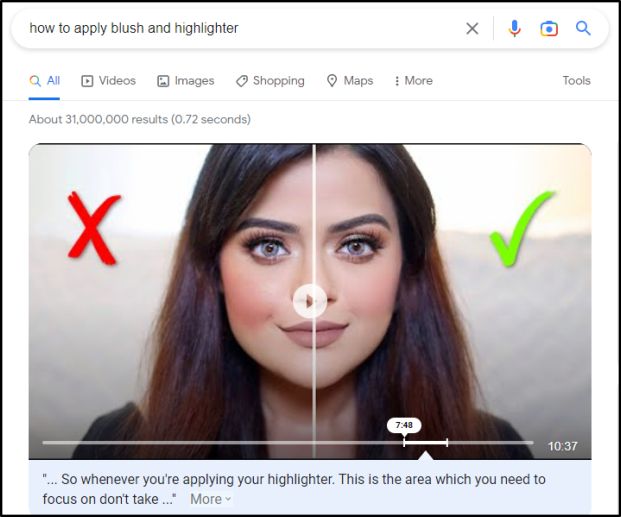
- Entity carousel:
A snippet that can be modified using bubble modifiers is called a “carousel featured snippet.” Google places keyword suggestions with carousel-featured snippets at the top or bottom of the snippet that is relevant to the user’s search terms. The highlighted snippet’s content changes when one of these keywords is clicked.
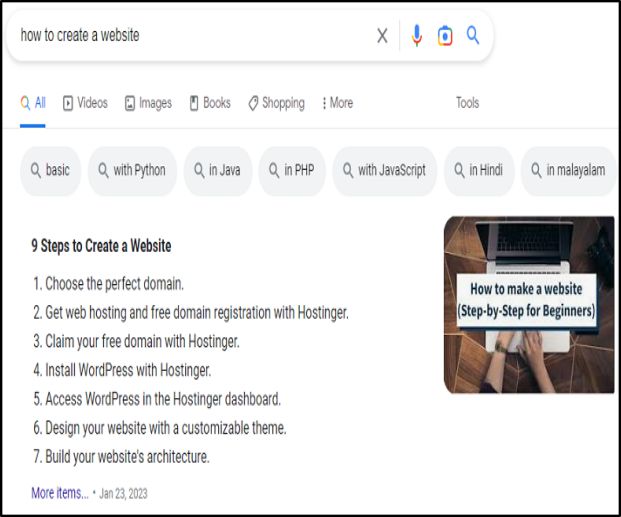
- Double-featured snippets:
Google often returns two sets of response boxes known as “double-featured snippets. These consist of the answers cited from two websites, often done in bullet points with both page names and URLs. Double-featured snippets are displayed when Google is unsure about the searcher’s intent.
You can rank for a double-featured snippet if your content is relevant to searchers’ intent or if it discusses the exact topic another site does.
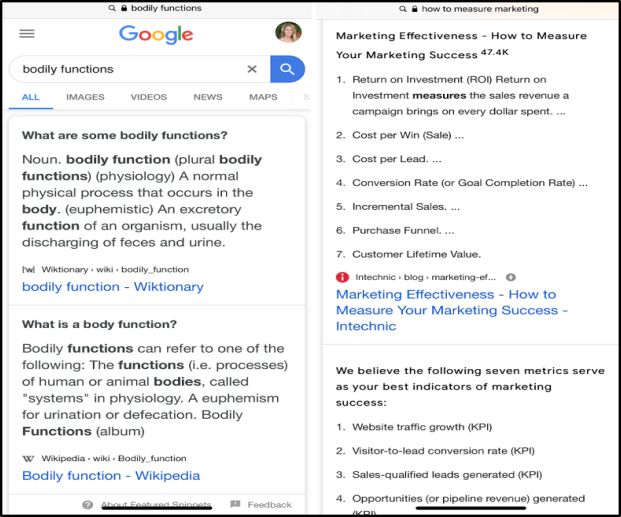
- Two-for-one or combined snippet:
Google occasionally uses information from many websites to respond to a user’s query. These types of featured snippets include many websites and show them as one continuous text (or text and images) related to a certain topic.
Useful, illustrative graphics can help your content rank for these featured snippets.

How to start getting featured snippets
Optimizing for Google’s featured snippets aims to concisely answer users’ questions with well-organized facts and captivating images.
Virtually every SEO professional aims for featured snippets as part of a campaign. Here are some ways to improve your chances of getting a featured snippets:
- Identify competitors’ featured snippets
Stealing featured snippets from competitors’ websites can be challenging, so you need to analyze their strategies carefully. Search competitors’ URLs and look for the keywords that earn them featured snippets. Now, perform these steps:
- Export the data
- Classify them into different categories of featured snippets
- Sort them according to search volume
- Highlight low keyword difficulty (KD) scores
- Gather the keywords for each featured snippet
After finalizing the content topics, find out which keywords are used in the content currently ranking for snippets. Collect all questions and related keywords and record them in your content template.
- Understand searcher intent
One of the critical steps in optimizing for featured snippets is understanding what the searcher intends. All in all, three types of people search for your keywords:
- Potential customers
- People who persuade customers in buying decisions, e.g. influencers
- Your competitors
Your content is intended for the first two. Everyone has different intentions for searching, and your content should always be informed. For a featured snippet, the intent may be:
- To get a specific answer
- To get a brief answer
- To get a comparison
- To get a video solution
You can hone in on one of these intents that matches the best with your content.
- Perform a competitive analysis
Input your content topic or keywords in an SEO content template tool. You will get SEO recommendations to help you plan the content to get featured snippets. It will show you the following information:
- Top 10 competitors
- Key recommendations regarding the content, like its length, readability, and backlinks
- Suggestions regarding how your competitors are using keywords (so that you can use them more effectively)
- Some basic SEO recommendations to create search-friendly content.
- Create better-structured content
After knowing about your competitor’s strategies, you can try to create better content to optimize a potential snippet. You should keep the following points in mind to improve your content:
- Cover the information that users want.
- Create more value in your content by adding statistical data, examples, pointers, and other specifics.
- Use simple language and short sentences to improve the readability of your content.
- Give importance to research-based content instead of opinion-based content.
- Create “How to” content specifically answering users’ queries.
- Update your content
Now you have everything you need to create content that can earn featured snippets to your content, like topics, keywords, search intent, SEO recommendations, and more, you need to create an attractive outline for your content. And if the content is already written? Revamp it!
Following the above steps, you can earn Google’s featured snippet for your content. This can skyrocket your organic traffic as well as your business’s authority and reputation.
How do featured snippets work?
Featured snippets can appear anywhere, such as in standard search results, in association with Knowledge Graph data, or in the “People also ask” column.
Google shows highlighted snippets when the systems find a website’s format makes it easy for users to find the information they’re looking for. They are especially beneficial for those using mobile devices or doing voice searches.
Do I have a chance to get featured?
If your webpage does not rank on Google’s first search result page, the probability of getting featured snippets is very low, but not zero.
Several researchers say almost 100% of snippets are ranked in the top 10 results. So if you are already ranked in the 10 ten list for the search query, you have a high chance of getting featured. However, featured snippets can appear and disappear for a respective query.
Why do featured snippets matter?
Featured snippets matter because they are auxiliary SERP elements that you can secure. Featured snippets provide you more exposure to searchers and can increase brand awareness.
Additionally, featured snippets are important because they foster organic traffic. They have several related advantages, including:
- Increase CTR
- Increases your authority and credibility
- Optimizes for voice results
Featured snippets vs rich snippets: What’s the difference?
Rich snippets are just upgraded organic search results, but a featured snippet directly responds to a query at the top of organic search results. The two differ in some ways:
| Category | Featured snippets | Rich snippets |
|---|---|---|
| Appearance | These appear on the top of organic search results on the SERP page. The page is in the top 10 results for the given search. | A high ranking is usually necessary, but not 100% of the time. |
| Specifications | These are not categorized by industry. Most websites can respond to relevant queries with helpful information or precise statistics. | They only function with certain websites or types of information. |
| Generation | A content analysis is performed, taking into account analytical and on-page factors. | Any page’s structured information is used to retrieve snippets. |
| Impact on click-through rate (CTR) | They can improve CTR, but they may also provide consumers with enough information in SERPs to avoid the need to click. | They raise the CTR because of the improved exposure and focused results. |
How to keep track of your featured snippets
Tracking your featured snippets is crucial in order to do better over time and increase your frequency of snippets.
Here are a few ways to do so:
- Tracking Tools for Featured Snippets
You can use SEO tools to monitor your ranking for Google snippets and discover opportunities to enhance the content strategy for better results.
- Tracking Featured Snippets Manually
Utilize Google Search Console as a starting point to find keywords around which you could have a snippet. Examine your top 10 rankings for keywords, then focus on the “snippet-y” ones, such as query and comparative keywords.
You may simply examine the SERP in an anonymous browser when you rank for keywords that potentially offer highlighted snippets.
- Creating Reports of Featured Snippets
You can create reports for your featured snippets using automated tools. You can also analyze the featured snippet totals over time and the individual snippet keywords for each month to report on the snippet rankings.
You can easily track your featured snippets using tools or manual calculations.
Conclusion
Featured snippets are an amazing way to get noticed by searchers. However, featuring for any snippets requires comprehensive SEO strategies and concise content that can answer users’ queries. Additionally, one should keep track of their featured snippets as they change.



